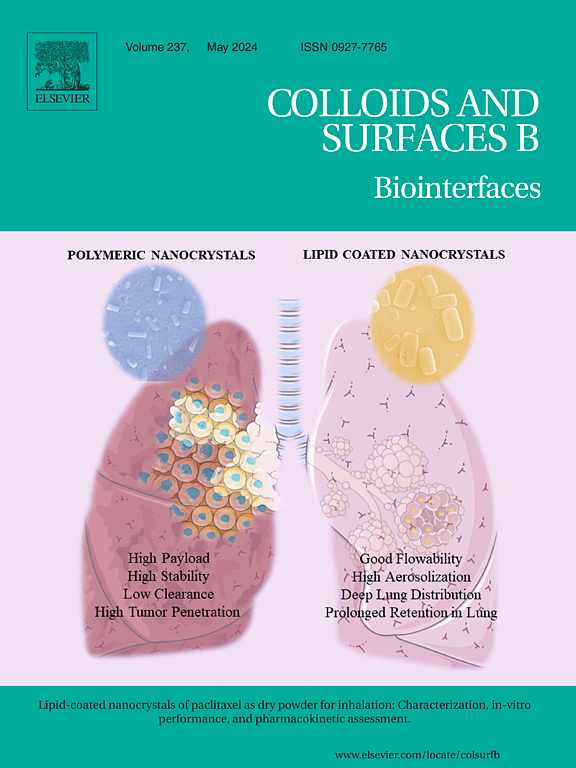用于可穿戴应变传感器的具有可调机械性能的三维印刷离子导电水凝胶
IF 5.6
2区 医学
Q1 BIOPHYSICS
引用次数: 0
摘要
柔性传感器作为可穿戴设备的重要组成部分,已经引起了人们极大的研究兴趣。然而,实现具有优异机械性能、高传感性能和宽应变范围的柔性传感器仍然具有挑战性。本研究对离子导电的N-(2-氨基-2-氧乙基)丙烯酰胺/羧甲基壳聚糖/甲基纤维素水凝胶进行了分析,并对其工艺参数进行了优化,以实现高保真水凝胶打印。此外,提出了一种双离子协同增强策略,其中通过溶液浸泡引入Fe3+和Li+来定制“刚性-韧性-韧性”平衡网络,显著提高了水凝胶网络的力学性能。实验结果表明,经双离子处理后的水凝胶具有优异的力学性能,弹性模量可达266 kPa,韧性可达1245 kJ/m3,断裂伸长率可达437 %,抗膨胀性能显著。此外,三维打印的网状水凝胶具有高灵敏度,应变系数为2.57,检测范围宽(0-300 %),并且在60 %应变下具有出色的100次循环疲劳耐久性。将水凝胶集成到柔性传感器中,可以高精度地检测细微和大规模的人体运动,从而推进导电水凝胶在可穿戴电子产品中的应用,并为柔性传感器的设计和开发提供新的见解。本文章由计算机程序翻译,如有差异,请以英文原文为准。
Three-dimensional printed ionic conductive hydrogels with tunable mechanical properties for wearable strain sensors
Flexible sensors have garnered significant research interest as essential components of wearable devices. However, achieving flexible sensors with superior mechanical properties, high sensing performance, and a broad strain range remains challenging. In this study, an ion-conducting N-(2-Amino-2-oxoethyl) acrylamide/carboxymethyl chitosan/methyl cellulose hydrogel was analyzed, and its process parameters were optimized to enable high-fidelity hydrogel printing. Furthermore, a dual-ion synergistic enhancement strategy was proposed, wherein Fe3+ and Li+ were introduced via solution immersion to tailor a “stiff-tough-ductile” balanced network, significantly enhancing the mechanical properties of the hydrogel network. Experimental results showed that the dual-ion-treated hydrogels exhibited outstanding mechanical properties, with a modulus of elasticity of up to 266 kPa, toughness reaching 1245 kJ/m3, elongation at break of up to 437 %, and remarkable resistance to swelling. Additionally, the three-dimensional-printed reticulated hydrogel exhibited high sensitivity, a strain factor of 2.57, a broad detection range (0–300 %), and excellent fatigue durability over 100 cycles at 60 % strain. Integrating hydrogels into flexible sensors enables the high-precision detection of both subtle and large-scale human body movements, thereby advancing the application of conductive hydrogels in wearable electronics and offering new insights for the design and development of flexible sensors.
求助全文
通过发布文献求助,成功后即可免费获取论文全文。
去求助
来源期刊

Colloids and Surfaces B: Biointerfaces
生物-材料科学:生物材料
CiteScore
11.10
自引率
3.40%
发文量
730
审稿时长
42 days
期刊介绍:
Colloids and Surfaces B: Biointerfaces is an international journal devoted to fundamental and applied research on colloid and interfacial phenomena in relation to systems of biological origin, having particular relevance to the medical, pharmaceutical, biotechnological, food and cosmetic fields.
Submissions that: (1) deal solely with biological phenomena and do not describe the physico-chemical or colloid-chemical background and/or mechanism of the phenomena, and (2) deal solely with colloid/interfacial phenomena and do not have appropriate biological content or relevance, are outside the scope of the journal and will not be considered for publication.
The journal publishes regular research papers, reviews, short communications and invited perspective articles, called BioInterface Perspectives. The BioInterface Perspective provide researchers the opportunity to review their own work, as well as provide insight into the work of others that inspired and influenced the author. Regular articles should have a maximum total length of 6,000 words. In addition, a (combined) maximum of 8 normal-sized figures and/or tables is allowed (so for instance 3 tables and 5 figures). For multiple-panel figures each set of two panels equates to one figure. Short communications should not exceed half of the above. It is required to give on the article cover page a short statistical summary of the article listing the total number of words and tables/figures.
 求助内容:
求助内容: 应助结果提醒方式:
应助结果提醒方式:


